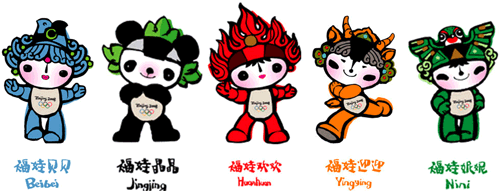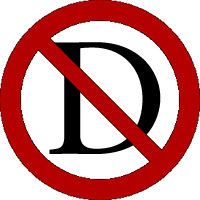 Beijing has unveiled its five mascots for the 2008 Olympics, the Friendlies Fuwa. They are dubbed Beibei, Jingjing, Huanhuan, Yingying, and Nini. Here’s Jingjing, the friendly PRC panda, with his gun. In case you’re wondering, yes, that’s an official image.
Beijing has unveiled its five mascots for the 2008 Olympics, the Friendlies Fuwa. They are dubbed Beibei, Jingjing, Huanhuan, Yingying, and Nini. Here’s Jingjing, the friendly PRC panda, with his gun. In case you’re wondering, yes, that’s an official image.
OK, back to language-related matters. These aren’t just saccharine names for cutesy figures: there’s a pattern. Note how each name is a doubled syllable, which is a common way to form affectionate nicknames in Mandarin. (My wife, for example, is named Hsin-chun, but many in her family refer to her as Hsin-hsin.)
Taking the first syllable of each of the mascot names yields “bei jing huan ying ni,” or, more properly, “Beijing huanying ni,” which is “Beijing welcomes you” in Mandarin. If tones are indicated this would be written Běijīng huānyíng nǐ; but tone indications are completely unnecessary here for easy comprehension of the meaning. Although Mandarin is a tonal language, most clearly written texts do not need to have all or even most tones indicated for comprehension by fluent speakers.
Let’s look at the sentence “Beijing huanying ni” when written in characters. It’s “北京欢迎你” in simplified Chinese characters. In traditional characters it would be written “北京歡迎你.” But the names of the mascots aren’t all written with these same characters. For that matter, not even all the tones are the same:
| Beijing welcomes you | mascot names | ||
|---|---|---|---|
| character | tone | character | tone |
| 北 | běi | 贝 | bèi |
| 京 | jīng | 晶 | jīng |
| 欢 | huān | 欢 | huān |
| 迎 | yíng | 迎 | yíng |
| 你 | nǐ | 妮 | nī |
北北 (lit. “North-north”) just doesn’t make for a catchy mascot name. But, basically, the only way to use Chinese characters to indicate the third-tone bei sound of “Beijing” is with the 北 character. So the mascot namers went with a different character — and consequently a different tone, too. They opted for bèi.
By the way, readers of Chinese characters have no choice but be accustomed to characters being pronounced with a variety of tones. Some 80 percent of Chinese characters that have more than one pronunciation — and these are quite common — are associated with at least two tones.
Chinese does have a word pronounced bèibèi. It is written in characters thusly: 孛孛. The meaning is “radiant,” which sounds nice enough for a mascot name. But almost no one knows this old word. For that matter, most people don’t even know the obscure 孛 character and thus wouldn’t know it’s supposed to be pronounced bei. (Note how a character doesn’t have to have a large number of strokes to be obscure.)
Thus, 孛孛 obviously wouldn’t work. So the designers used a bèi that is rather more precious. When 贝 is doubled, the association is with baobei (treasure), as in something a mother might call her child (just as an Italian woman might sometimes fondly refer to her child as “tesoro”). Thus, an English translation of “Beibei” would be something like “Precious.” (Normally I’m opposed to translating names. But in this case some translation is appropriate, as these names are most certainly designed to be cute as a button and so should be revealed as such.)
Let’s move on to Jingjing. Using, say, the “proper” character for Beijing’s jing would yield 京京, which means “intense (of sorrow).”
念我独兮、忧心京京。
哀我小心、癙忧以痒。I think how I stand alone,
And the sorrow of my heart grows intense. (tr. James Legge)
Even though that’s such an ancient term that almost no one would know it now, it’s probably still not the sort of thing Beijing’s Olympic planners would want as a mascot name. So 晶, which has the same pronunciation (including tone) as Beijing’s jing was selected. An English translation of “Jingjing” would be something like Crystal, or perhaps Sparkles.
Huan and ying are used unchanged. Indeed, Huanhuan is found as a personal name; an English version of this name would be “Joy.” But “Yingying” doesn’t translate well; “Welcome” is about the best I can think of at the moment.
With Nini, again we have a different character and a different tone. (Then there’s the selection of ni rather than the more polite form of nin. This might make an interesting entry by itself.)
Mandarin does have a word pronounced “nǐnǐ.” It means “luxuriant; exuberant; flourishing” — perhaps not entirely out of line for a name. But then comes the matter of the character; this word is written 苨苨. But 苨 is used only in 苨苨. Although in this case the phonetic part of the character (as opposed to the “radical”) is relatively clear, 尼, the character is nonetheless not nearly common enough for people to know whether it is pronounced (probably, that is — because Chinese characters are not unlike a spelling system that’s two thousand years out of date) nī, ní, nǐ, or nì. And at any rate, even if people did know the correct pronunciation, they still wouldn’t know the meaning of 苨苨. In short, 苨苨 is also a bad choice.
There’s a more common “nini,” which has different tones: níní (泥泥). This has two meanings: (1) damp (from dew), and (2) luxuriant; thick (of vegetation). The 泥 character, unlike 苨, is not uncommon. Nonetheless, the word níní (泥泥) is obscure, which would lead most people to guess at the meaning, and most of them would probably guess something like “muddy.” So this choice wouldn’t be a good one either.
The marketing managers decided to use 妮 (nī), which is used in nīr (妮儿/妮兒), a word for “girl.” This yields the decidedly twee “Nīnī,” which might be translated as “Girly.” (Note that the phonetic is the same as in the above: 尼.)
Here are Precious, Crystal, Joy, Welcome, and Girly:


 [Updated version.] A Mr. Hu (胡) in Dengfeng, China, wants to give his son the name “胡D”. In case anyone’s not clear on this, yes, that’s a letter from the alphabet, not a Chinese character that happens to look like the letter D. (The name would have been the same had the baby been a girl, he said.) But this is being blocked.
[Updated version.] A Mr. Hu (胡) in Dengfeng, China, wants to give his son the name “胡D”. In case anyone’s not clear on this, yes, that’s a letter from the alphabet, not a Chinese character that happens to look like the letter D. (The name would have been the same had the baby been a girl, he said.) But this is being blocked.